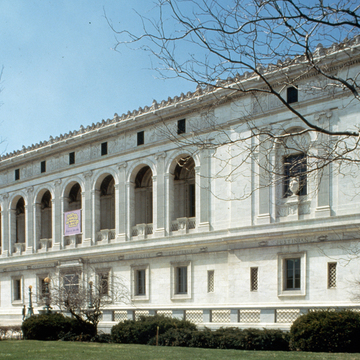The Detroit Public Library is a symbol of cultural life in Detroit. The majestic, white Vermont marble building is surrounded on three sides by terraces. Gilbert, one of America's most prominent architects, designed it in the classical mode of the early twentieth century. In scale and wall treatment the building is more French than Italian. The library's restrained symmetrical facade is broken on the first story by molded openings and flat-headed windows. There is an arched loggia with fluted Ionic pilasters on the second floor, while small squared windows and bas-relief panels adorn the frieze. Inside, a double row of Doric columns lines the central east–west hall, and off the hall, staircases on the north and south rise to the second floor. Each staircase begins as a single flight but splits at a landing and ascends to a lofty barrel-vaulted hall. Here the rich golds, reds, greens, and blues of the ceiling explode into view in stunning contrast with the white marble. The colorful ceiling, together with the series of wall murals painted by Edwin H. Blashfield to depict great artists, musicians, and writers, anticipates the murals and stained glass windows of Adam Strohm Hall in what was the main book delivery room. Three arches in the east wall of this huge room contain murals by native Detroit artist Gari Melchers (1860–1932) showing historical events and allegorical subjects in the early settling of Detroit: The Landing of Cadillac's Wife, The Conspiracy of Pontiac, and The Spirit of the Northwest. The two groupings of three painted glass windows in this room were designed by Frederick J. Wiley. The fireplace of the original children's reading room is adorned with some of the city's most cherished Pewabic tiles illustrating storybook characters.
The Cass Avenue entrance, with Millard Sheets's brilliantly colored mosaic allegorically depicting knowledge and library services, was added in 1963. At the same time the north and south white marble wings were built to provide space for the browsing and children's libraries and the Burton Historical Collection.









